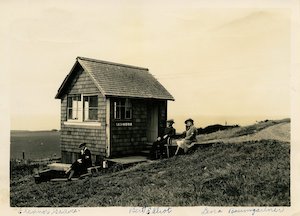Photograph of Eleanor Sverko, Burtt Elliott, and Lena Baumgartner at one of the Army Air Force’s World War II aircraft warning stations. According to Alvin Mendosa, this one was located on the hill near Mendocino High School. The sign on the station wall reads, “19 Rose-5-O.P.” Hand-written on the bottom border of the photographic print are the names “Eleanor Graves, Bertt Elliot, Lena Baumgartner.”

Aircraft Warning Station in Mendocino, 1941-1944. (Gift of Emery Escola, Emery Escola Collection, Kelley House Photographs)
Burtt Elliott was the chief observer at the Mendocino station. Other nearby warning stations included one located in Cleone, headed up by Frank Hyman, and one on Keene Summit in Comptche.
HISTORY: In May 1941, civilian volunteers acting as airplane spotters were organized, with the help of the American Legion, into the Aircraft Warning Service (AWS), the civilian arm of the Army’s Ground Observer Corps. This was a response to the new threat of wide-ranging bombing planes loaded with highly explosive bombs capable of ranging far from home base and potentially attacking America.
These early-warning observation posts were set up all around the country, including coastal and inland areas of Mendocino County. Their 24-hour per day mission was to keep watch for enemy planes entering American airspace and report to a central “filter center” that coordinated the sightings with known “friendly” aircraft in the area to determine if an enemy plane was present. Once the United States entered World War II on December 7, 1941, many of those who could not join the military, for whatever reason, were recruited to the AWS. Statistically, this led to a preponderance of women.
Each post had its own code name and number. When aircraft were spotted, the volunteers would record their observations on forms or in log books and then quickly place a call to a regional Army Filter Center and verbally deliver a “Flash Message,” which contained the organized data from the observation. Aircraft approaching the coast would often be spotted by multiple posts, resulting in multiple Flash Messages and, therefore, a reasonably accurate triangulation of position, speed, direction, altitude, etc.
On the west coast, AWS posts ranged from upper Washington to lower California and were under the auspices of the 4th Interceptor Command (later Fourth Fighter Command or IV Fighter Command) based in Riverside, California. The center for northern California was located in Sacramento, the second most important aircraft warning station in the state, which coordinated with the central information center in San Francisco. There, all the flying services and agencies maintained a staff of liaison officers and gave the center a detailed flight plan of every friendly plane. Thus, the presence of enemy aircraft could be detected easily. Volunteers worked 24 hours a day to plot flights, staff the battery of telephones, and transmit information from filter rooms to operation rooms and from one filter center to another.
According to a contemporary newspaper account, “At the filter center in Sacramento, one group of women sit with headphones receiving information from observation posts on the location of planes. They use small rakes to move the markers indicating the planes on the large chart in front of them. They always are on the alert for reports of new planes whose existence has not been charted. Another group sits in a balcony overlooking the massive colored chart able to read its cryptic information at a glance, and relaying it to the central information center in San Francisco.” (Sacramento Bee, 31 Jul 1943, p. M-2)
All observers received extensive training in aircraft recognition. This training was so successful that it spilled over into the non-AWS population. Aircraft recognition became a significant hobby providing many with thousands of hours of entertainment and spawning many books and publications, including flashcards, on the subject. Many participated in contests and recognition “Bees.” Recognition clubs and meetings flourished, becoming a major social phenomenon of the day. Of significant note to the training effort was the use of black, hard rubber, spotter models for various aircraft. Often mistaken for poor quality toys, these models can be worth hundreds of dollars and need to be preserved as part of AWS history. (Wikipedia)
From Maidens to Mavericks, Mendocino’s Women by Molly Dwyer – Mendocino boasts some strong and remarkable women in its past. This volume honors and remembers some of them. For anyone who loves Mendocino, who lives on the Coast or claims some piece of it for themselves, discovering our foremothers can be transformational. $20.